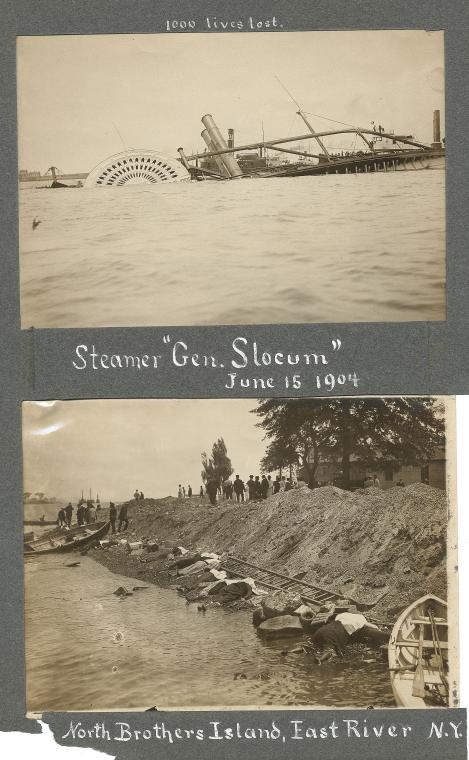
As the ship approached 97th Street, crewmembers on the lower deck noticed clouds of smoke rising from the floorboards and rushed down below to the second cabin. As the crew had never conducted a fire drill, they frantically tried to hose down the fire; however, the old hoses burst.
Onlookers on the shores of Manhattan described what they saw as one of the most horrific images they’d ever seen. Unable to make it to a safe place to dock in time, passengers jumped overboard -- many of whom did not know how to swim. One newspaper described it as “a spectacle of horror beyond words to express—a great vessel all in flames, sweeping forward in the sunlight, within sight of the crowded city, while her helpless, screaming hundreds were roasted alive or swallowed up in waves.” Hundreds huddled together in the last minutes of their life as they baked to death. In the mayhem, a woman even gave birth, and when she jumped overboard with her and her baby, they both perished.
A witness reported that they had seen a white yacht nearby from the New York Yacht Club, with the captain simply watching making no effort to rescue the passengers. He did not even lower a boat.
Staff from a nearby hospital by the river noticed the fire as the boat approached the shore and many rushed to rescue those they could. Many staff tossed ropes to those still stuck inside the ship, and others even dove into the waters to rescue badly burned passengers still struggling to make it to shore. Nonetheless, the immense heat that had engulfed almost the entirety of the ship made it practically impossible for rescuers to get close enough to the ship without roasting alive either. Crews from other boats following the Slocum pulled dozens living and dead out of the water.
In total, the death toll of 1,021, most of them women and children, made the burning New York’s worst disaster until 9/11. Captain Van Shaick of the Slocum faced criminal charges for criminal negligence and failure to maintain proper fire hoses and extinguishers and served four years in prison. The fire was believed to have been started by a carelessly tossed match or cigarette that ignited a barrel of hay. The tragedy of this event compelled more steamboats to take safety precautions.
This event ultimately meant the thousands of men of Little Germany were without families. It wouldn’t be until a new wave of Polish and Russian immigrants did Kleindeutschland reappear in New York.
Sources:
https://www.smithsonianmag.com/history/a-spectacle-of-horror-the-burning-of-the-general-slocum-104712974/
https://en.wikipedia.org/wiki/PS_General_Slocum
https://www.nypl.org/blog/2011/06/13/great-slocum-disaster-june-15-1904
This post is very informative and detailed. I wanted to do some research on what happened to some of the other crew-members and people from the company that owned the ship, the Knickerbocker Steamship Company. Of everyone involved only Captain Van Schaick was convicted. However, two inspectors as well as the president, treasurer, commodore, and secretary of the company were indicted. President Theodore Roosevelt refused to pardon Captain Van Schaick, but the William H. Taft administration did. The company itself did not have much of a punishment. They were only fined a small amount.
ReplyDeleteSource:
https://en.wikipedia.org/wiki/PS_General_Slocum
This was a really well written and informative post. Prior to reading this I had never heard of the General Slocum and the tragedy that came with it. I looked into Little Germany more and found that in the 1860s it was one of the most populated areas of New York city. Which demonstrates the magnitude of this tragedy. Many of the families that were on the steamship were from wealthy families whom were little Germany's "social foundation", which meant that this tragedy resulted in the damaging of the social aspect of Little Germany as well. After the tragedy Little Germany was severely weakened and anti-german sentiment that surfaced during WW1 was what cemented the end of Little Germany.
ReplyDeletehttps://www.6sqft.com/kleindeutschland-the-history-of-the-east-villages-little-germany/
https://www.businessinsider.com/why-there-are-almost-no-germans-in-new-york-2015-8
I thought that you did a really great job of capturing the mass detail of this tragic story and creating as well as providing imagery to allow the reader to be fully immersed. I thought the detail you included really assisted in conveying the tragedy of the situation. I thought this blog post was very different from other posts and really stood out, since most posts are about loss of life due to planned attack or war, this post was a interesting contrast.
ReplyDelete